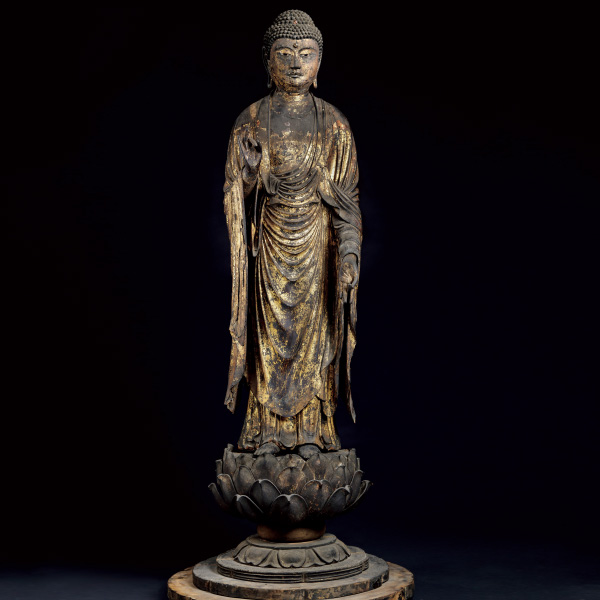
動画による作品解説
・年代:鎌倉時代(13世紀)
・法量:像高99.8cm
Standing Statue of Amida Nyorai
Era: Kamakura period (13th century)
Dimensions: Height of the statue 99.8 cm
西方の極楽浄土に住み、信仰する者を死後、浄土に迎えとるとされた阿弥陀如来の立像。頭体幹部(頭部と体の主要部分)を一材でつくった上、前後に割って内刳を行う一木割矧造の像で、瞳には水晶製の玉眼をはめ込んでいます。螺髪を後頭部でV字形に配し、像底を上げ底式に刳り残す点などは慶派仏師の特徴で、着衣の形式や流麗な衣文線、秀麗な面貌などから、快慶に学んだ仏師の作品と考えられます。なお、通常立像は、両足裏に足枘を作り、台座上面の穴に差し込むのが普通ですが、本像は蓮台上に2本の棒を立て、これを踵の後方に開けた2つの穴に差し込んで立てており、足裏に漆下地を見ることができます。こうした特殊な特徴から本像は、足裏に千幅輪相(如来の足裏にある車輪型の文様)をあらわす像であった可能性があります。鎌倉時代、仏像の姿をなるだけ経典に忠実に再現することで、生身の仏を再現しようとする動きがありますが、本像はこのような生身仏のうち早い時期の作例の可能性が高く、学術的に貴重な仏像です。
A standing statue of Amida Nyorai, who resides in the Western Pure Land and is believed to welcome believers to the Pure Land after death. The head and main body are carved from a single piece of cypress wood, split front and back, and hollowed out inside, known as the ichiboku-zukuri technique. The eyes are inlaid with crystal. The spiral hair is arranged in a V-shape at the back of the head, and the bottom of the statue is hollowed out in a raised-bottom style, which are characteristics of the Kei school sculptors. The clothing style, flowing drapery lines, and elegant facial features suggest it is the work of a sculptor who studied under Kaikei.
Typically, standing statues have tenons on the soles of the feet that fit into holes on the top of the pedestal. However, this statue has two rods on the lotus pedestal that fit into two holes behind the heels, allowing the soles to show the lacquer base. These unique features suggest that the statue may have depicted the thousand-spoked wheel pattern on the soles of the Buddha's feet. During the Kamakura period, there was a movement to faithfully reproduce the appearance of Buddha statues according to scriptures, aiming to recreate the living Buddha. This statue is likely an early example of such living Buddha statues and is academically valuable.
